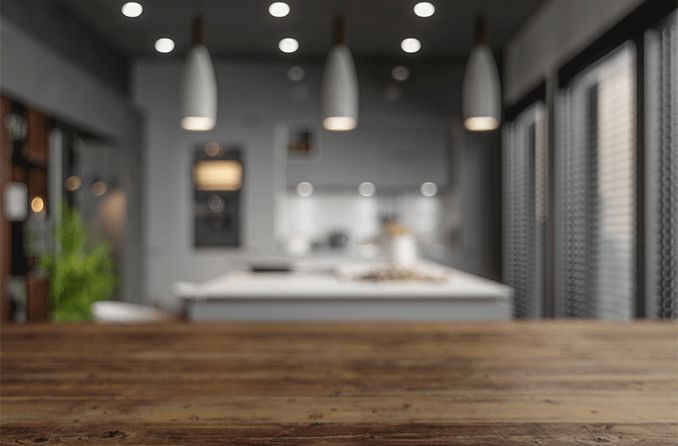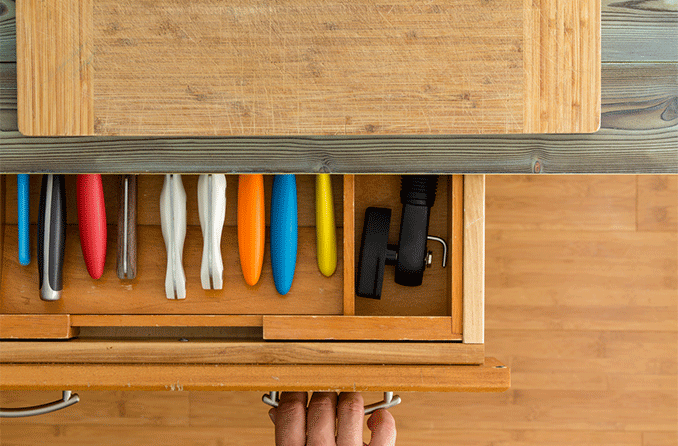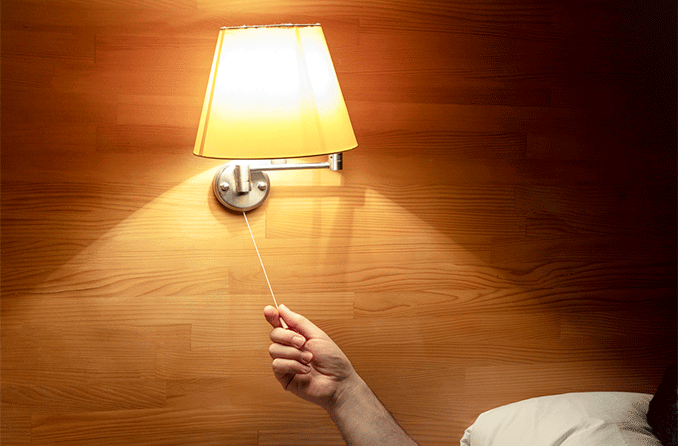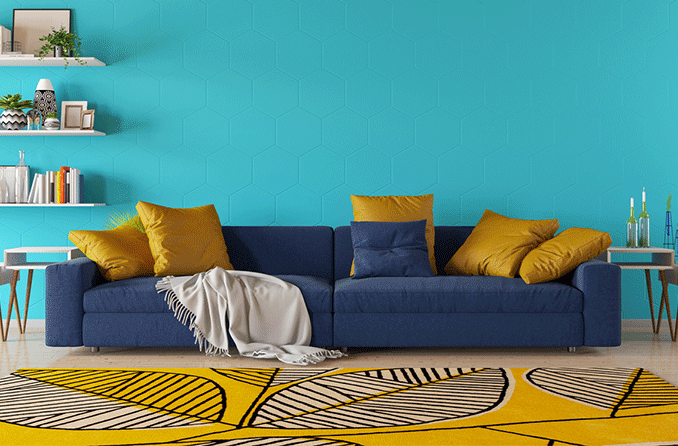How to create a home that accommodates visual impairment and blindness

Creating a safe, comfortable space is usually at the top of the list when choosing the layout and aesthetic of a home. For the visually impaired, designing a beautiful, yet secure and functional home may require some unique modifications.
Whether you are visually impaired or living with a visually impaired loved one, there are simple adjustments you can make to your home for better accessibility. Adding or changing even subtle details can make your home more welcoming to the visually impaired while maintaining its visual appeal.
Levels of visual impairment
According to the American Foundation for the Blind (AFB), visual impairment is a general term that describes the levels of visual function, varying from low vision to total blindness. It’s important to understand that “visual impairment” is not a definition that details what someone can or cannot see, but a term used to classify those who have poor or partial vision.
Variations of visual impairment consist of low vision, legal blindness, profound visual impairment and total blindness. The variations are determined based on a person’s visual acuity and/or visual field.
Visual acuity is how sharp one’s vision is, and distance visual acuity is typically measured during an eye test using a Snellen chart. “Normal” distance visual acuity is 20/20, which means you can read certain letters on the chart from 20 feet away, where most people should be able to read those particular letters.
A person’s visual field is the total area that can be seen (including peripheral vision) as they focus on a central object. The average human has a visual field of 120 degrees horizontally and 90 degrees vertically.
Low vision (also referred to as “moderate visual impairment”) describes a visual acuity of 20/70 or worse after corrective measures, including eyeglasses or contacts. Someone with this level of visual acuity would need to stand 20 feet away from a chart to read a specific line clearly, while someone with normal vision could read the same line clearly from 70 feet away.
Legal blindness is a category for people who have a visual acuity of 20/200 to 20/400 while wearing glasses or contacts. This also applies to those who have a visual field of 20 degrees or less. People who are legally blind are categorized as having “severe visual impairment,” which means they may be eligible for certain resources or disability benefits through the U.S. government.
Profound visual impairment describes a visual acuity of 20/500 to 20/1000 or a visual field of 10 degrees or less. Though their vision is very poor, people with profound visual impairment can still perceive the difference between light and dark, or daytime and nighttime. Additionally, they can recognize sources of light, such as a lamp or natural daylight through a window.
Total blindness specifies the inability to perceive any source of light or object form. This is a rare type of visual impairment, as only 15% of those who are visually impaired fall into this category.

Outdoor adjustments for the visually impaired
Making your home easier to maneuver begins before you even walk through the door. For those who have a front yard, it’s important to consider what obstacles may be present when approaching your home.
A good example of this is how straight and even your walkway is.
“If you still have some residual vision, a lot of times your balance is shot,” says Holly McKnight, president of the National Federation of the Blind chapter in Arlington, Texas. “So, walking on a curved walkway can be a real pain. The more straight you can keep things, the better.”
Other outdoor accommodations that may be helpful include:
Keeping grass, trees and hedges groomed appropriately to avoid hazards.
Ensuring the walkway to your home, as well as the front and back patios, have sufficient lighting. Motion-sensor lights are an energy-efficient way to achieve this.
Having door knobs or handles that are a contrasting color from the door, making them easier to identify.
Installing secure locks that are easy to operate.
Making sure your house number is large, clear and visibly placed on your home and/or in your yard.
Installing an intercom or phone security system so visitors can be identified before opening the door.
Finally, for people who have steps leading up to their front door, installing a handrail can increase safety for all guests.
“If you’re going to have more than one step, having a handrail can benefit anybody, whether they’re sighted or not,” McKnight explains.
Applying these simple features to the outside of your home can make all the difference for someone who is visually impaired.

Indoor adjustments for the visually impaired
When it comes to modifying the inside of a home to accommodate someone with poor vision, the details can seem overwhelming. For clarity and ease, a few key categories have been identified for which accommodations are required.
These categories and associated tips are outlined below.
Safety
It’s important for all home dwellers to feel safe where they live. For the visually impaired, this may take a few modifications to achieve, including:
Keeping floors clear of clutter and being mindful of the placement of low-to-the-ground furniture, such as coffee tables and ottomans.
Cleaning any spills or messes immediately to avoid injury.
Wearing finger caps when cutting or chopping to avoid cutting fingers accidentally.
Having smoke alarms examined regularly — a service that may be done for free through your local fire department.
Installing grab bars in necessary areas, including near the toilet or shower.
Avoiding or replacing flooring that is slippery or produces glare (floors with a glossy or shiny finish).
Installing a community alarm, which connects you to a member of your community if you need assistance at home.
Hanging picture frames or paintings above hand level, as to not interfere with a visually impaired person who needs to feel their way around the home.
Placing non-slip rugs or mats in the bathroom, shower and kitchen. Make sure the rugs are placed securely and are a contrasting color from the floor. Also, consider keeping any bathmats draped over the tub or put away except at bath/shower time.
Taping down edges of area rugs to help prevent trips and falls.
Planning and learning various routes to exit your home in case of an emergency that requires you to leave quickly.
SEE RELATED: How to Get a Guide Dog

Organization
While organization may not be a priority in all homes, it’s a must for those with poor vision. As McKnight explains it: “As a blind person, you can’t be messy.”
Here are a few ways to conveniently and safely organize your home:
Avoid letting clutter accumulate on countertops or shelves; this helps make it easier to find things and distinguish between specific items.
Push desk and table chairs in when they’re not in use.
Put items back in their proper place when you’re finished using them.
Organize furniture to create a clear, spacious walking path.
When it comes to organizing specific items or tools, such as in kitchens and bathrooms, there is no set rule. Rather, the person with the visual impairment must establish their own organizational method.
“Organizing the kitchen drawers or cabinets with a system that makes sense to the person who is visually impaired is important,” McKnight explains.
To keep things organized, it’s also critical for sighted people who live with someone visually impaired to understand, respect and adhere to the organizational method.
“You have to keep your living space in a way where you can use it, and remind whoever you live with that those things are done that way for a reason.”

Lighting
Lighting is extremely important for anyone visually impaired who can sense sources of light. However, while bright lighting is certainly beneficial in most cases, simply stuffing your home full of lamps may not be the best solution.
Natural light is often preferred over fluorescent lighting, as it is more consistent and is less likely to cast shadows. Here are some ways to create helpful, comfortable lighting in your home:
Increase natural light in the home, and have blinds or curtains installed so you can adjust as necessary.
Install adjustable, glare-reducing window shades that allow you to control how much light comes into a room.
Ensure places, including hallways, stairs and entryways, are well lit.
Avoid unnecessary shadow formation by putting all house lights at the same height.
Install lights in closets, cupboards and small, dark spaces to provide direct light.
Position lights intentionally, so they’re focused on objects and surfaces rather than a person’s face. For instance, ensure lights shine directly onto a work surface.
Arrange televisions, computers and any other screens so light will not fall directly on them and create a glare.

Color contrast
Those who are visually impaired may have a difficult time differentiating various items that are all the same color. For this reason, using color contrast can help communicate important information and make your home easier to navigate.
Some ways to do this include:
Making sure the walls and floors are different colors. It may also help to paint a different colored band where the walls and floors meet.
Choosing furniture that is a contrasting color from its surroundings.
Installing door handles that are a different color from the doors.
Using paint or colored tape to line the edges of any stairs or steps inside or leading into the house. This helps identify where the steps begin, how many steps there are and how high/steep they are.
Changing the color of light switch plates to contrast with the color of the walls.
Ensuring important, frequently used items are a different color from their surroundings. This includes toilets, sinks, faucets and shower knobs, as well as clothes hangers, toothbrushes and other items used daily.
Using tape or paint to outline the edges of countertops to make it easy to see where they begin and end.
Having a chopping board that is lightly colored on one side and dark on the other, which makes it easier to see what you’re chopping.

Cater to the sense of touch
The visually impaired often rely on their sense of touch to enhance what they cannot see. While braille is a tactile way to read, there are some other touch-based shortcuts for people with poor vision, including:
Buying furniture with textured upholstery, which may help one recognize where they are in the house, based on the texture.
Having handrails that begin before the first step of the stairs, and extend beyond the last.
Applying Styrofoam letter stickers on any items that may need differentiating. For example, placing the letter “F” under the switch that activates the fan.
Using bump pads to identify buttons on a microwave, dishwasher or other appliances that may be “buttonless.”
Marking personal items, so everyone can distinguish what is theirs and what is someone else’s. An example of this is placing a rubber band around a glass or toothbrush.
Having certain marks embroidered on inconspicuous parts of clothing, so they’re easier to identify.
READ NEXT: Do blind people dream?
What to avoid in a home modified for the visually impaired
Making accommodations for the visually impaired doesn’t entirely consist of adding things to your home. There are also a number of items and features that should be avoided or changed to make your home more accessible. Some examples of what to avoid include floors, furniture and rugs with patterns.
“If I throw a dog toy and it lands on a patterned area rug, it disappears into the abyss,” McKnight explains, as patterned materials tend to blur together when viewed by the visually impaired.
In addition to busy patterns, it’s important to avoid having loose wires or electrical cords in the home. It’s recommended to group any cords and tape them down to prevent accidents.
It’s also important to avoid focusing only on accessibility and neglecting the appearance of your home.
Visually impaired or not: Almost everyone takes pride in how their home looks and feels. Don’t assume a family member or roommate with visual impairment won’t care about aesthetics, or that they must be resigned to the fact that their home will look blatantly different than a sighted person’s home.
“We want things to be as aesthetically pleasing as sighted people do,” says McKnight. “We don’t want our home to say ‘a blind person lives here.’ That’s not what we’re going for.”
Making your house accessible for the visually impaired does not mean stripping away the beautiful, personal touches that make it your home. But applying some or all of the modifications mentioned above will ensure that your home is safe and welcoming for all who step inside.
READ NEXT: How to make the internet easier to navigate with impaired vision
Making a House Accessible for a Visually Impaired Person. WeCapable. Accessed March 2021.
Adapting Your Home for a Child Who Is Blind or Has Low Vision. FamilyConnect. Accessed March 2021.
Adapting your home. Royal National Institute of Blind People. Accessed March 2021.
Normal Vision Field. American Academy of Ophthalmology. Accessed March 2021.
Low Vision and Legal Blindness Terms and Descriptions. American Foundation for the Blind. Accessed March 2021.
Visual Field. MedlinePlus, National Library of Medicine. Accessed March 2021.
Home Modifications for Visual Impairment. The Blind Guide. December 2017.
Page published on Wednesday, April 7, 2021






